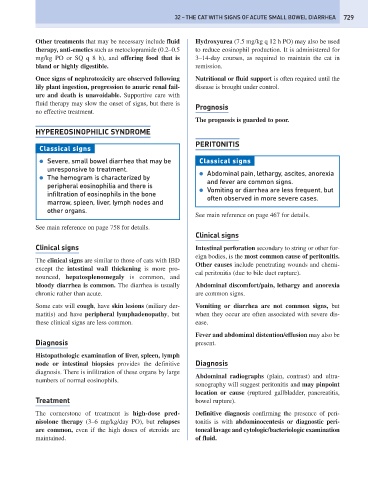Page 737 - Problem-Based Feline Medicine
P. 737
32 – THE CAT WITH SIGNS OF ACUTE SMALL BOWEL DIARRHEA 729
Other treatments that may be necessary include fluid Hydroxyurea (7.5 mg/kg q 12 h PO) may also be used
therapy, anti-emetics such as metoclopramide (0.2–0.5 to reduce eosinophil production. It is administered for
mg/kg PO or SQ q 8 h), and offering food that is 3–14-day courses, as required to maintain the cat in
bland or highly digestible. remission.
Once signs of nephrotoxicity are observed following Nutritional or fluid support is often required until the
lily plant ingestion, progression to anuric renal fail- disease is brought under control.
ure and death is unavoidable. Supportive care with
fluid therapy may slow the onset of signs, but there is
Prognosis
no effective treatment.
The prognosis is guarded to poor.
HYPEREOSINOPHILIC SYNDROME
PERITONITIS
Classical signs
● Severe, small bowel diarrhea that may be Classical signs
unresponsive to treatment.
● Abdominal pain, lethargy, ascites, anorexia
● The hemogram is characterized by
and fever are common signs.
peripheral eosinophilia and there is
● Vomiting or diarrhea are less frequent, but
infiltration of eosinophils in the bone
often observed in more severe cases.
marrow, spleen, liver, lymph nodes and
other organs.
See main reference on page 467 for details.
See main reference on page 758 for details.
Clinical signs
Clinical signs Intestinal perforation secondary to string or other for-
eign bodies, is the most common cause of peritonitis.
The clinical signs are similar to those of cats with IBD
Other causes include penetrating wounds and chemi-
except the intestinal wall thickening is more pro-
cal peritonitis (due to bile duct rupture).
nounced, hepatosplenomegaly is common, and
bloody diarrhea is common. The diarrhea is usually Abdominal discomfort/pain, lethargy and anorexia
chronic rather than acute. are common signs.
Some cats will cough, have skin lesions (miliary der- Vomiting or diarrhea are not common signs, but
matitis) and have peripheral lymphadenopathy, but when they occur are often associated with severe dis-
these clinical signs are less common. ease.
Fever and abdominal distention/effusion may also be
Diagnosis present.
Histopathologic examination of liver, spleen, lymph
node or intestinal biopsies provides the definitive Diagnosis
diagnosis. There is infiltration of these organs by large
Abdominal radiographs (plain, contrast) and ultra-
numbers of normal eosinophils.
sonography will suggest peritonitis and may pinpoint
location or cause (ruptured gallbladder, pancreatitis,
Treatment bowel rupture).
The cornerstone of treatment is high-dose pred- Definitive diagnosis confirming the presence of peri-
nisolone therapy (3–6 mg/kg/day PO), but relapses tonitis is with abdominocentesis or diagnostic peri-
are common, even if the high doses of steroids are toneal lavage and cytologic/bacteriologic examination
maintained. of fluid.

